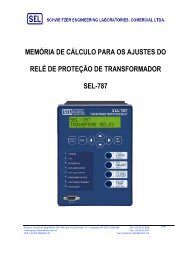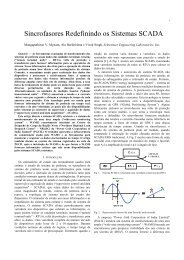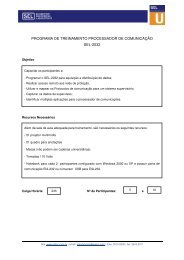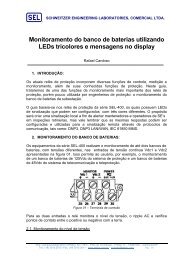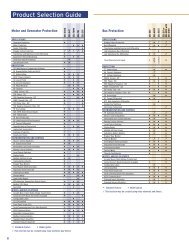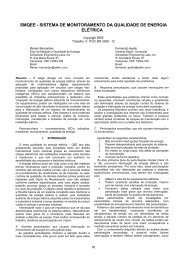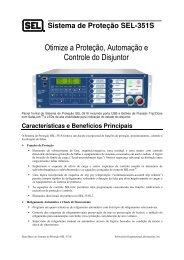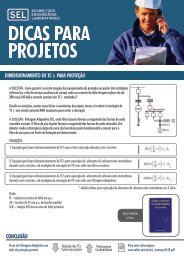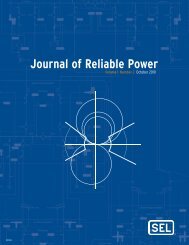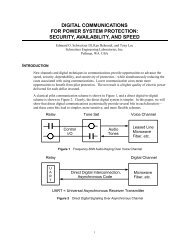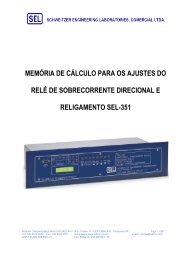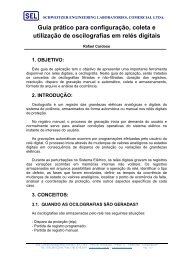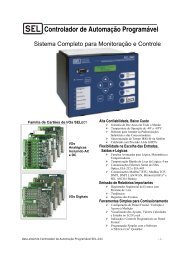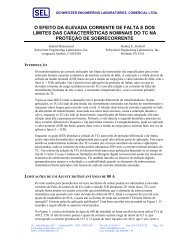Journal of Reliable Power - SEL
Journal of Reliable Power - SEL
Journal of Reliable Power - SEL
Create successful ePaper yourself
Turn your PDF publications into a flip-book with our unique Google optimized e-Paper software.
9<br />
The three-phase fault detection element is obtained by<br />
using current self-polarization. For example, the BC loop<br />
would be polarized with:<br />
predict the impedance trajectory, and stability studies may be<br />
required.<br />
S2 = j(IRB − IRC)e − jT<br />
(16)<br />
To avoid overreach because <strong>of</strong> forward flowing load, the<br />
setting T in degrees is a tilt, most likely downward, for the<br />
reactive line. The resistive reach is polarized with positivesequence<br />
current.<br />
The three-phase quadrilateral element just described is set<br />
with the same reach as the phase-to-phase distance elements.<br />
It does require certain load considerations to avoid load<br />
encroachment.<br />
If the transmission line is long and the resistive setting<br />
chosen conflicts with load, a load encroachment element is<br />
required. This element should clearly define the load area in<br />
the forward load flow direction. Fig. 17 illustrates a traditional<br />
and already widely used load-encroachment logic<br />
characteristic. The operating point <strong>of</strong> the load impedance in<br />
this region will clearly identify load conditions and prevent<br />
the three-phase fault detection algorithm from operating.<br />
Fig. 17.<br />
jX<br />
Load<br />
Load encroachment for quadrilateral three-phase distance elements<br />
C. Out <strong>of</strong> Step<br />
Much <strong>of</strong> the theory and discussion in literature on out-<strong>of</strong>step<br />
detection can be applied to quadrilateral distance<br />
elements [16][17]. When power flows are oscillating in a<br />
power system, the apparent impedances measured by the<br />
distance elements describe a trajectory on the R-X plane.<br />
These oscillations can be caused by angular instability or<br />
simply switching lines in or out [17]. If the oscillations are<br />
contained within a maximum oscillation envelope and are<br />
damped over time, the power swings are considered stable. On<br />
the other hand, if the power swings are not damped over time,<br />
the power swings are said to be unstable.<br />
On the R-X diagram shown in Fig. 18, a stable power<br />
swing impedance trajectory is contained on the right side (or<br />
the left side for reverse power flow) and eventually rests on a<br />
new load-impedance operating point. An unstable power<br />
swing, in contrast, will show a trajectory that crosses the plane<br />
from left to right (or right to left). Theoretically, and assuming<br />
the simple two-source network shown in Fig. 18, the unstable<br />
power swing will cross the electrical center <strong>of</strong> the system<br />
when the angle’s difference between the two source voltages<br />
is close to 180 degrees apart. Unless the power system can be<br />
reduced to a two-source model, it is not a simple matter to<br />
R<br />
Fig. 18.<br />
Traditional dual-zone out-<strong>of</strong>-step characteristic<br />
During power system oscillations, stability requirements<br />
demand that transmission lines remain in the power system.<br />
Tripping transmission lines unnecessarily jeopardizes the<br />
stability <strong>of</strong> the power system. It is therefore necessary to<br />
ensure that unstable trajectories on the R-X diagram entering<br />
distance element characteristics (shown in Fig. 18) do not<br />
unnecessarily trip the transmission line. However, some<br />
applications require tripping transmission lines in a controlled<br />
manner.<br />
Out-<strong>of</strong>-step detection techniques traditionally take<br />
advantage <strong>of</strong> the slower speed <strong>of</strong> the apparent impedance<br />
trajectory on the R-X diagram for power swing conditions.<br />
The trajectory <strong>of</strong> the operating point changes from load to<br />
fault almost instantaneously for fault conditions.<br />
Fig. 18 illustrates a traditional scheme comprised <strong>of</strong> two<br />
zones. If the inner zone operates after a set time delay (2 to<br />
5 cycles), an out-<strong>of</strong>-step condition is detected. If the trajectory<br />
is due to a power system fault, both zones will operate within<br />
a short time window.<br />
There are several philosophies to follow when setting the<br />
parameters <strong>of</strong> this scheme [17]. Some <strong>of</strong> the most important<br />
considerations are:<br />
• The inner zone should not operate for stable swings.<br />
As shown in Fig. 18, a stable swing eventually returns<br />
to the load impedance.<br />
• The outer zone should not include any possible load<br />
impedance. If load is included by the outer zone, there<br />
is a risk <strong>of</strong> incorrectly declaring a power swing<br />
condition.<br />
• The distance from the inner to the outer zone on the<br />
impedance plane should be made as wide as possible<br />
to allow the detection <strong>of</strong> the power swing condition.<br />
• The inner zone should not include any distance<br />
element zone that is to be blocked. For long line<br />
applications, achieving this goal for all distance zones<br />
may not be possible. We can place the inner zone<br />
across part <strong>of</strong> the distance element characteristic. This<br />
will effectively cut part <strong>of</strong> the characteristic.<br />
Adaptive Phase and Ground Quadrilateral Distance Elements | 73



